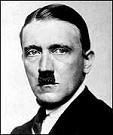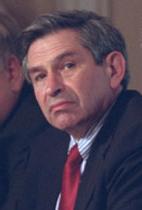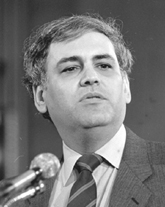STRAUSSIAN FASCISM

When the armed forces of the United States of America unleashed hell on the nation of Iraq on March 19, 2003, only the gullible believed that justice was being served. According to President George W. Bush, and Prime Minister Tony Blair, the official cause for the attack was the need to remove weapons of mass destruction from Iraq, which, according to Blair, could be deployed in 45 minutes! Those whose memory was any longer than a few weeks, however, would have recalled that Bush, Blair, and key individuals in around their respective administrations had previously sought war against Iraq for entirely different reasons. Initially it was alleged that the Iraqi regime had ties with al-Qaeda. When the allegations proved to be false, war was sought on the pretext that the Iraqis would not comply with United Nations inspectors. When the Iraqi’s complied, they were accused of deceit. It soon became clear that no Iraqi, including Sadaam Hussein himself, could do anything to prevent Iraq from being the target of what turned out to be one of the most destructive military campaigns in human history.
Curiously, an attempt to understand how the United States, the one-time “Temple of Liberty and Beacon of Hope,” could have degenerated so completely as to commit such a grand atrocity, begins with a return to intelligence methods familiar to the government of the United States during World War II. At that time, the United States intelligence services maintained extensive files on an extremely influential, clandestine group known as the “Synarchists,” which had what now seems to be an impossible membership including both Nazi’s and Communists. (It is easily shown, however, that pre-World War II Nazi’s and Communists shared similar racist, Gnostic, and imperialist doctrines, which formed the basis of the notorious Hitler-Stalin pact.) Accordingly, the Synarchists were classified under the file, “Nazi-Communism.”
The history of Synarchism begins no later than the 1860’s with the publication of the first Synarchist text, written by Joseph Alexandre Saint-Yves, a follower of Napolean Bonaparte’s mystical advisor, Antoine d’Olivet, whose occult writings included themes of “purgative violence,” and the “will to power” now familiar to any reader of Friedrich Nietzsche. A follower of Saint-Yves, Gerard Vincent Encausse, founded the Saint Yves School of Occult Sciences, and thereafter, a secret society called the “Synarchy Government,” which recruited leaders of industry, commerce, finance, the military, and academia. The main political aim of the Synarchy Government was to destroy what they called the “internal microbe” of society—anarchism.
In 1922, under the leadership of Count Richard Coudenhove-Kalergi, the Synarchists spawned a public front called the Pan European Union, whose aim was to create a unified European state modeled on the Napoleonic Empire. The first mass rally of the Pan European Union was addressed by Hjalmar Schact, who, along with Bank of England Governor Montagu Norman, became the chief architect of the Bank of International Settlements, and later, Adolf Hitler’s finance minister. The 1930 creation of the Bank of International Settlements, still in operation today, was seen as an important step in realizing the Synarchist Pan European Union. Among the early converts to the scheme was Benito Mussolini, who found much to admire in the philosophy underlying Synarchism.
In 1932, Synarchist media magnate Lord Beaverbrook of the London Daily Express deployed his trusted aide Selfton Delmer to accompany Adolf Hitler on the campaign trail. Delmer became a confidant of Hitler and gained notoriety as the journalist who clinched the Hitler coup by spreading the lie that a Communist burned the Reichstag. Hitler fit the Synarchist plot well until he attacked his benefactors in Great Britain during World War II.
At about the same time, the United States government managed to procure a 1940 French intelligence document defining Synarchism as a plot “to check any new social schemes which might tend to weaken the power of the international financiers and industrialists; to work for the ultimate complete control of all industry by international finance and industry; to protect Jewish and Anglo-Saxon interests;… to take advantage of Franco-German collaboration to conclude a series of agreements with German industries, thereby establishing a solid community of interest between French and German industrialists, which will tend to strengthen the hands of international finance and industry;… to effect a fusion with Anglo-Saxon industry after the war.” The report went on to explain that “Some headway is claimed to have been made in securing the adhesion of big U.S. industry to the movement.”
Among the Synarchists active in Europe was one Alexandre Kojève, who started off as a Russian Bolshevik and ended up serving the Nazis in Vichy France. In his latter role as an academic, he maintained a close working relationship with one Leo Strauss, whom, as we shall see, is the key to our story.



Carl Schmitt Adolf Hitler Leo Strauss
Leo Strauss gained his entrance into elite academia under the sponsorship of Carl Schmitt, also known as the Crown Jurist of the Nazis. Strauss shared Schmitt’s philosophy that, since all men are evil, all political groups are necessarily formed against—necessarily—foes. As a law professor in Berlin in 1930, Schmitt argued that the individual who best defines the foe is the true sovereign and rightful dictator. This philosophy was so agreeable to Adolf Hitler, that when he became the dictator of Germany, he commissioned Carl Schmitt to conform all German laws to Nazi theory. Schmitt reported directly to Herman Göring, the founder and leader of the Gestapo. Strauss, meanwhile, left Germany and went to France with a Rockefeller foundation scholarship that Schmitt helped him to receive. Though Strauss was Jewish, and eventually fled to the United States, he maintained a cordial correspondence with his Nazi benefactor. For example, in one letter to Schmitt, Strauss wrote, “The ultimate foundation of the Right is the principle of the natural evil of man; because man is by nature evil, he therefore needs dominion. But dominion can be established, that is, men can be unified, only in a unity against—against other men. Every association of men is necessarily a separation from other men. The tendency to separate (and therewith the grouping of humanity into friends and enemies) is given with human nature; it is in this sense destiny, period.”
By 1938 Strauss was a teacher at the New York School of Social Research. He remained there until 1948, when he left to teach political science at the University of Chicago. He wrote several books which obscured his cynical philosophy that there is no truth, no universal principle, no natural law, and no virtue. Traditional values are fictions that are useful only to control the masses. Accordingly, Strauss developed a unique style of teaching which separated his students into “gentleman” and elite “philosophers.” Gentleman are the so-called “exoterics,” who are taught to believe in traditional values. They are the useful fools who serve the “philosophers,” or “esoterics,” who are taken aside and individually taught to think like Strauss. Dominion, is the ultimate goal.
Strauss’s most gifted students, including Allan Bloom, who famously authored The Closing of the American Mind, were sent to Paris to receive additional training from none other than Alexandre Kojève, whom Strauss viewed as the greatest of philosophers. Kojève imbued his students with his Synarchist glorification of purgative violence, and the twisted idea that only a slave-master is truly human. Strauss and Kojève maintained a close working relationship until the latter’s death in 1968. One of their main projects was the rehabilitation of Carl Schmitt, who had been banned from teaching at the Nuremburg tribunals. Strauss died in 1973, but not before he had trained a loyal cadre of self-described “Straussians,” many of whom now serve in various posts in the United States government, and government bureaucracy.



Paul Wolfowitz Richard Perle Lewis Libby
One of the first Straussians to enter public service in the United States was a young fellow named Paul Wolfowitz, who now serves as Deputy Director of Defense, and was arguably the strongest voice for war against Iraq. In fact, Wolfowitz had advocated the violent overthrow of Sadaam Hussen since the late 1970’s. Other Straussians in key posts include Richard Perle of the Defense Policy Board, Lewis Libby, who serves as Vice-President Dick Cheney’s Chief of Staff, and Abram Shulsky, who heads the Special Planning Group, a Pentagon special unit set-up by Defense Secretary Rumsfeld to falsify intelligence data in order to justify the destruction of Iraq. The obvious conclusion, first come to by Democratic presidential candidate Lyndon LaRouche, was that a cabal of Straussian neo-fascists had effectively taken the reigns of power, and had used that power to assert their violent will.
The case of Paul Wolfowitz is particularly informative. As early as May 21, 1991, he led a team, including fellow Straussian Lewis Libby, which presented to then Secretary of Defense Dick Cheney a policy of “preemptive” war to prevent any nation or combination of nations from challenging American dominance. When Cheney attempted to implement this policy as part of his 1992 Defense Planning Guidance, leading military figures were outraged. The Defense Planning Guidance had to be rewritten. Nonetheless, eleven years later, with Cheney in the Vice-Presidency, the outrageous and illegal policy of preemptive war became a reality. The only precedent was Adolf Hitler’s 1939 blitzkrieg into Poland.
However, nobody, including the most rabid Straussian, could credibly argue that poor Iraq, even if it had weapons of mass destruction (which it did not) could pose anything more than a regional threat. Certainly Iraq posed no threat to the United States. Why, then, was Iraq targeted? Could it have been that Iraq was so weakened by decades of war and sanctions that its wealth of petroleum was an irresistibly easy conquest? Or is there more to consider?
Vice President Dick Cheney’s post-Iraq War appointment of Princeton University Professor Aaron Freidberg to the position of Deputy National Security Advisor may provide the appropriate clue. Freidberg is yet another Straussian. He was a founding member of a key think-tank called “Project for the New American Century,” which is run by two more prominent Straussians—William Kristol, and Gary Schmitt. Freidberg, however, is best known as one of the most sophisticated “China Hawks”—those who claim that China is the United States’ greatest threat, in spite of the fact that professional estimates place China decades behind the United States in military capability.
The clearest expression that China is viewed as the ultimate foe by the Straussians is found in a 1999-2000 RAND study under the direction of Zalmay Khalilizad and Abram Shulsky. In this study, Shulsky wrote, “Chinese reforms since 1978 have given rise to unprecedented economic growth; if this course of development is sustained, China will be able to turn its great potential power, derived from its huge population, large territory, and significant natural resources, into actual power.” Shulsky’s solution is “the need to threaten high levels of violence to deter China.” Such is the case with Straussian foreign policy.

On the domestic front, the Straussians are equally brazen. Attorney General John Ashcroft, the highest law enforcement official in the United States, is a Straussian. Shortly before he came to that post during the outset of the Bush Administration, Democratic Presidential candidate Lyndon LaRouche warned publicly and repeatedly that the appointment of John Ashcroft, under present conditions of crisis, would lead to a situation not unlike the burning of the Reichstag which precipitated the establishment of Adolf Hitler’s dictatorship. Therefore, it should have surprised no one that Ashcroft followed the burning of the World Trade Center with a demand for what is tantamount to dictatorial, emergency rule. For example, under John Ashcroft’s legislation, private communications—phone-calls, e-mails, etc.—are subject to unrestrained law enforcement eavesdropping. Any person may be secretly arrested and detained indefinitely, without private or legal counsel, if they are deemed to be an “enemy combatant”—a vague term which could potentially be applied to anyone. In court, government prosecutors can secretly submit information to the court without the defense having the ability to challenge that information. Potentially, these and many other atrocities can be leveled against anyone under the cover of “national security.”
With the current Straussian-dominated regime hell-bent on a foreign policy which can only be described as World War III, and a domestic policy resembling the Gestapo, all but the dead should be searching for an exit strategy.